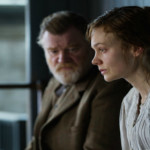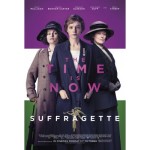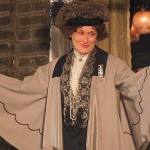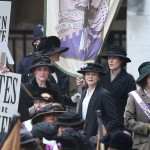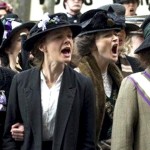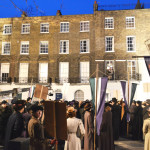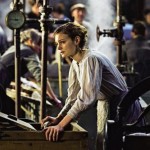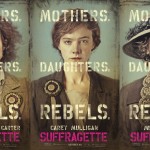Suffragette, directed by Sarah Gavron, is a worthy and widely praised film about part of the struggle for universal suffrage at a time when virtually the whole world treated women as chattel, when working conditions in many industries such as laundries were abysmal and crippling to the women forced to work in them, and when civil disobedience as a tactic was practically unknown – decades before Martin Luther King‘s civil rights campaign.
The charismatic and enigmatic Emmeline Pankhurst, here portrayed in a brief cameo by the charismatic and enigmatic Meryl Streep, just the sort of role you would expect to attract her attention, delivered a phenomenal culture change within society, quite apart from among the unflinching misogynists of Westminster, so it is only right and proper that the story should be celebrated on film, nearly a century after women over 30 were given the right to vote in the UK.
Except the movie tells the first-hand story of Maud Watts (Carey Mulligan), a wife, mother and laundry-forewoman; it tells of her radicalisation to become a suffragette; how she addresses but is betrayed by Lloyd George; how she is arrested and goes on hunger strike; and how she witnesses the demise of Emily Davison (who was in reality neither as young nor as pretty as Natalie Press) under the hooves of the King’s horse at the Derby – though the movie paints this as an intentional act, which many historians dispute; maybe the most tragic of all, it shoes how Watts loses her husband and beloved son in the course of the struggle.
The movie ends with the funeral of Davison in 1913, attended by thousands and widely thought of as the catalyst for change in voting rights (which began in 1918), supplemented by the common device of further events in text over the images – thus avoiding the Lincoln dilemma of displaying the political machinations leading to the bill being passed. It is intended as a personal, female narrative, and that is what it delivers. The only thing we learn about the political process is that it promises one thing and delivers another – but then we all knew that, didn’t we?
One point of interest is that this is the first movie where permission was granted to film inside the Palace of Westminster, which for the sake of authenticity is beyond parallel. In fact, the meticulously researched historical accuracy and production design of Suffragette are up there with the best. This aspect of the film fully deserves an Oscar.
However, it is far from clear from the film whether all the women shown are based on real people or are fictionalised, nor how far the real events have been amended for dramatic effect, the age old issue with biopics. Thankfully, Wikipedia assists us in this regard:
- Carey Mulligan as Maud Watts (fictional)
- Helena Bonham Carter as Edith Ellyn (fictional).While Ellyn was not a real person, she was somewhat inspired by Edith Garrud; Bonham Carter modelled her performance after Garrud and requested the character’s name be changed from Caroline to Edith in honour of her. Bonham Carter is the great-granddaughter of H. H. Asquith, who served as Prime Minister of the United Kingdom in 1908–16, the prime years of the suffrage movement, which he opposed.
- Meryl Streep as Emmeline Pankhurst (real person)
- Natalie Press as Emily Davison (real person)
- Anne-Marie Duff as Violet Miller (fictional)
- Romola Garai as Alice Haughton (fictional)
- Brendan Gleeson as Steed (fictional)
- Ben Whishaw as Sonny Watts (fictional)
- Samuel West as Benedict (fictional)
- Adrian Schiller as David Lloyd George (real person)
In short, Pankhurst, Davison and Lloyd George apart, this is a work of fiction, so in my view it should be labelled as such. Indeed, it makes you wonder what was wrong with the real life suffragettes that their lives should not be immortalised in this story.
Not that you could complain about the acting: Mulligan, Press and la grande dame Streep apart, there is plenty to admire in the combined talents of Helena Bonham Carter, Romola Garai, Anne-Marie Duff (aka Mrs James McAvoy), Ben Whishaw, Samuel West and Adrian Schiller – fine actors all, playing their roles with all-consuming and convincing passion.
However, in my eyes the acting honours go to the marvellous Brendan Gleeson, here playing Inspector Arthur Steed with a veneer of sympathy but a seam of underlying cruelty. His job is to enforce the law, and if that means alternating between good and bad cop, so be it. The subtlety of this performance puts in perspective all the cop shows you’ve seen before. Gleeson simply can do no wrong in my eyes. Every appearance, from the weary assassin in In Bruges, to the cynical Garda in The Guard, to “Mad-Eye Moody” in the Harry Potter franchise – in fact, look at his CV and you’ll find a prolific character actor who has appeared in a host of top movies and often out-acted the stars.
Abi Morgan‘s script certainly provides the case with plenty of bullets to fire and without unduly gilding the lily, though it takes itself way too seriously – perhaps weighed down by the need to be seen as worthy. It has been criticised for focusing exclusively on the lot of women and ignoring the many other prejudices and injustices of 1912 society, though being truly fair and balanced would surely make a movie unwatchable. My issue is that with barely a hint of humour to alleviate the mood, it tells a po-faced narrative likely to make minor characters cardboard cutout polemics – and such is the fate of police and politicians, both seen as the villains of the piece. As a piece of social history it has value, but misses a lot more opportunities.
However, my real issue with the movie, the humdinger that drags it down, is Gavron’s insistence on using hand-held camera, many unfocused close-ups and unnecessary rapid cutting. I felt queasy in the first minute and it barely improved for the 106 minute duration. Was this really necessary? Yes, I understand the desire for immediacy and intimacy in the cinematographic style, but frankly it detracts from the emotional impact of the narrative and does the movie no favours. Who wants to feel seasick watching a movie on dry land?
Granted my hearing is less than perfect, but to my ears a muffled sound track with mumbled words failed to deliver the audio quality I need. Why did actors stop enunciating clearly? There must be a reason, but it seems to be a truism the world over that movies and TV dramas are not spoken with the crystal clarity you used to expect. If this is to be the norm perhaps all movies should come with subtitles – which from my perspective would be very welcome.
These flaws make Suffragette barely watchable at times, a great shame given the captivating skill with which it has been realised.



